Papers by cody ames
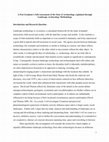
Landscape archaeology is, in essence, a conceptual framework for the study of peoples’ interactio... more Landscape archaeology is, in essence, a conceptual framework for the study of peoples’ interactions, both sacred and secular, with the land they occupy and modify. It also institutes a scope of what modernity holds as important or even essential to humanity, and it has experienced a great shift in spacial and self-awareness in recent years. The agency present between landscape archaeology (for example) and modernity is similar to looking in a mirror; one object reflects distinct characteristics relative to the other which is non-existent without the other object. In other words, it is through the likes of scholarship, i.e. archaeology, that we are truly able to scientifically evaluate and document what modern society regards as significant to contemporary living. Consequently, because landscape archaeology and archaeologists deal with culture and nature as mutually exclusive entities at times, the discipline itself is inherently multidisciplinary (or often understood as fractured) in its approach to studying, recording, and interpreting/leveraging people’s connections and dealings with the locations they inhabit. In light of this, I will leverage Bruno David and Julian Thomas who break the relatively new discourse, circa mid 1970’s, into a series of observations centered on how different ethnicities envisioned the world, which then influenced their interactions with other peoples across diverse spaces.
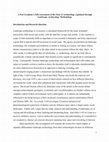
Landscape archaeology is, in essence, a conceptual framework for the study of peoples’ interactio... more Landscape archaeology is, in essence, a conceptual framework for the study of peoples’ interactions, both sacred and secular, with the land they occupy and modify. It also institutes a scope of what modernity holds as important or even essential to humanity, and it has experienced a great shift in spacial and self-awareness in recent years. The agency present between landscape archaeology (for example) and modernity is similar to looking in a mirror; one object reflects distinct characteristics relative to the other which is non-existent without the other object. In other words, it is through the likes of scholarship, i.e. archaeology, that we are truly able to scientifically evaluate and document what modern society regards as significant to contemporary living. Consequently, because landscape archaeology and archaeologists deal with culture and nature as mutually exclusive entities at times, the discipline itself is inherently multidisciplinary (or often understood as fractured) in its approach to studying, recording, and interpreting/leveraging people’s connections and dealings with the locations they inhabit. In light of this, I will leverage Bruno David and Julian Thomas who break the relatively new discourse, circa mid 1970’s, into a series of observations centered on how different ethnicities envisioned the world, which then influenced their interactions with other peoples across diverse spaces.
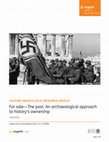
Cogent Arts & Humanities, 2017
An Archaeological Approach to History's Ownership: Since we were young, our teachers, parents and... more An Archaeological Approach to History's Ownership: Since we were young, our teachers, parents and tutors have drilled pattern recognition into our subconscious, so by the time we reach maturity, it is second nature to 'make things fit'. As a result, this paper focuses on the process of taking the abstract object and turning it into something which is seemingly tangible, relatable and able to grant power by identifying events in the past and crafting them into a modern perspective-making passed events contemporary manipulations. In other words, this analysis deals with humankind's desire to control and attempts to own the elusive past by creating a desired, beneficial and, often times, faux historical narrative through an extremely limited human perspective of history to solidify the present and shape the future. Two case studies which demonstrate this model include: (1) the suspect acquisition of the Parthenon (or Elgin) Marbles and (2) the mid-twentieth century's (specifically the Second World War) abuse of ancient, sacred iconography-the swastika. By leveraging these two didactics, I argue history is neither set in stone nor truly in the past.
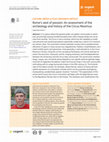
Cogent Arts & Humanities, 2016
It is a place where the general public can gather communally to watch ludi, provisionally erasing... more It is a place where the general public can gather communally to watch ludi, provisionally erasing invisible boundary lines which sharply divide one social class from another. The Circus is also a location which has the capability to eradicate personal and societal perceptions potentially rendering a crowd in an intoxicated, wanton state. The association existent between society and its predetermined allocation of space in many venues (e.g. hippodromes, theaters, amphitheaters, etc.) which exhibit sports and spectacles, more generally, is well attested to in the Circus Maximus's history. Using this as the conceptual framework, this article attempts to assess the recurrent, measured, and far-ranging evolutions and interdependencies between the aristocracy and the Circus they constructed. The construction methodology, I argue, was constantly being adapted to suit specific political agendas beginning with its legendary foundation under the Etruscan kings in the sixth-century BCE and ending with its usage during late Empire in the fifth-century CE. The fictional rape of the Sabine women, for example, relates Roman notions of losing self and spatial awareness as a hazardous mistake which can be purposely leveraged by manipulating a predestined, popular situation "monstra." The organization of this article which traces the Circus's transitions will begin with the Regal Period, move to the Republican Period, then to the Empire. The variations and modifications the
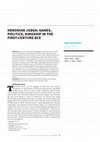
This article will detail the kingship of Herod the Great in Judea and his enrollment of Greco-Rom... more This article will detail the kingship of Herod the Great in Judea and his enrollment of Greco-Roman architecture and culture during his reign in the first century BCE. Herod, it seems, made a deliberate break from his Jewish kingdom for the electrifying ways of the Greco-Roman world. Herodian Judea faced many changes over its history, but none more drastic in terms of architecture and culture than during his reign amidst the Roman domination in Judea, a period that begins with Pompey the Great in 63 BCE and ends with the Muslim invasion in the 650's CE (Herod died in 4 BCE). Herod the Great is widely regarded as both a Roman sympathizer (OGIS 414) and a promoter of Greco-Roman. He is believed to have underwritten the construction of monumental buildings including harbors, temples, and arches as well as theaters and amphitheaters. These architectural endeavors, which bear strong Greco-Roman cultural significances, suggest Herod may have been influenced by Greek designs which were...
JOURNAL OF ANCIENT HISTORY AND ARCHAEOLOGY, 2015
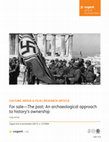
An Archaeological Approach to History’s Ownership: Since we were young, our teachers, parents and... more An Archaeological Approach to History’s Ownership: Since we were young, our teachers, parents and tutors have drilled pattern recognition into our subconscious, so by the time we reach maturity, it is second nature to ‘make things fit’. As a result, this paper focuses on the process of taking the abstract object and turning it into something which is seemingly tangible, relatable and able to grant power by identifying events in the past and crafting them into a modern perspective—making passed events contemporary manipulations. In other words, this analysis deals with humankind’s desire to control and attempts to own the elusive past by creating a desired, beneficial and, often times, faux historical narrative through an extremely limited human perspective of history to solidify the present and shape the future. Two case studies which demonstrate this model include: (1) the suspect acquisition of the Parthenon (or Elgin) Marbles and (2) the mid-twentieth century’s (specifically the Second World War) abuse of ancient, sacred iconography—the swastika. By leveraging these two didactics, I argue history is neither set in stone nor truly in the past.
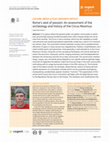
It is a place where the general public can gather communally to watch ludi, provisionally erasing... more It is a place where the general public can gather communally to watch ludi, provisionally erasing invisible boundary lines which sharply divide one social class from another. The Circus is also a location which has the capability to eradicate
personal and societal perceptions potentially rendering a crowd in an intoxicated, wanton state. The association existent between society and its predetermined
allocation of space in many venues (e.g. hippodromes, theaters, amphitheaters, etc.) which exhibit sports and spectacles, more generally, is well attested to in the Circus
Maximus’s history. Using this as the conceptual framework, this article attempts to assess the recurrent, measured, and far-ranging evolutions and interdependencies
between the aristocracy and the Circus they constructed. The construction methodology,
I argue, was constantly being adapted to suit specific political agendas beginning with its legendary foundation under the Etruscan kings in the sixth-century BCE
and ending with its usage during late Empire in the fifth-century CE. The fictional rape of the Sabine women, for example, relates Roman notions of losing self and
spatial awareness as a hazardous mistake which can be purposely leveraged by manipulating a predestined, popular situation “monstra.” The organization of this
article which traces the Circus’s transitions will begin with the Regal Period, move to the Republican Period, then to the Empire. The variations and modifications the Circus Maximus has undergone since the sixth-century BCE—architecturally and usage wise—serves as evidence to both the flexibility of public spaces and usages by the aristocracy from pre-Roman times through the Roman Empire.
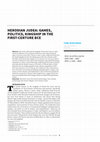
This article will detail the kingship of Herod the Great in Judea and his enrollment of Greco-Rom... more This article will detail the kingship of Herod the Great in Judea and his enrollment of Greco-Roman architecture and culture during his reign in the first century BCE. Herod, it seems, made a deliberate break from his Jewish kingdom for the electrifying ways of the Greco-Roman world. Herodian Judea faced many changes over its history, but none more drastic in terms of architecture and culture than during his reign amidst the Roman domination in Judea, a period that begins with Pompey the Great in 63 BCE and ends with the Muslim invasion in the 650’s CE (Herod died in 4 BCE). Herod the Great is widely regarded as both a Roman sympathizer (OGIS 414) and a promoter of Greco-Roman. He is believed to have underwritten the construction of monumental buildings including harbors, temples, and arches as well as theaters and amphitheaters. These architectural endeavors, which bear strong Greco-Roman cultural significances, suggest Herod may have been influenced by Greek designs which were filtered through Roman culture.
The cult of Hippolytus is a mystery religion thus making the analysis of the cult somewhat of a p... more The cult of Hippolytus is a mystery religion thus making the analysis of the cult somewhat of a problem. Practitioners of the cult left behind clues that enable classicists and archaeologists the ability to shed partial light on the mystery that includes several divine and semi-divine figures and geographic locations. These clues can be found in literature as well as empirical remains therefore this paper will have occasion to span different classical writers along with different cultures in addition to texts and archaeological remains.

Augustus found Rome a city of brick and left it a city of marble (Suetonius De Vita Caesarum). B... more Augustus found Rome a city of brick and left it a city of marble (Suetonius De Vita Caesarum). By his own admission, Augustus wanted to initiate a shift in the Roman political landscape when he instituted a monumental building program including art, architecture and politico-religious festivals (Res Gestae 1). These initiatives were all seemingly bent toward crafting a new political agency between the Principate and the common people. To this end, the Augustan building program and its political impact is outlined in the Res Gestae, heralded through monumental architecture, and sanctified through games and religious festivals. “The power of rhetoric is to make the dissenter feel lonely (Latour 1987: 44)”, so by projecting imperialism through multiple politically impactful mediums, I argue that Augustus was attempting to explicitly establish himself as the central power in Rome during the late first-century BCE and early first-century CE. As such, this paper will investigate the Augustan building program’s potential for establishing Augustus’ imperial aims. It will also detail how the building program can offer insight into understanding the economy and general state of Rome while under his leadership. Augustus’ inclinations for an imperial complexion for Rome was hardly derived from a vacuum; rather, it was decades in the making following in the footsteps of powerful men of the Greek East (Alexander) and Roman Republic (Sulla, Pompey, and Caesar) allowing him to make significant, lasting and imperial impressions on Roman culture (Armstrong 2006: 132-146; Hingley 2005: 1-3).
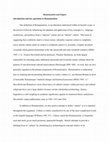
One definition of Romanization, or acculturation understood within its broader scope, is the proc... more One definition of Romanization, or acculturation understood within its broader scope, is the process of heavily influencing the adoption and application of key concepts (i.e. language, architecture, and politics) from a “superior” culture into an “inferior” culture. This trend of suggesting that a militarily (and to a lesser extent, culturally) superior culture is completely active and the culture under its control is completely passive is, presently, a largely devalued viewpoint which gained momentum in the late nineteenth and early twentieth-centuries (Millet 1992: 1-2). Francis Haverfield and his professor, Theodor Mommsen, are both largely responsible for educating many influential nineteenth and twentieth-century scholars about the patterns of one-directional cultural matriculation (McGeough 2009: 300). As such, they are also generally regarded as the primary proponents of Romanization. Romanization is understood here as studying and documenting alterations in a native culture (i.e. pre-Roman Britain) in favor of noticeably Romanesque “material changes and historical processes (Millet 1992: 1).” Haverfield and Mommsen’s keen observances of cultural variance within provinces and cultural subgroups have cast a large shadow because current scholarship (archaeology, history, linguistics) is still weighing its academic significance against its modernist theory undertones—Haverfield’s major publications came in 1905, 1913 and 1924.
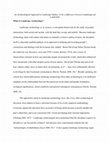
Landscape archaeology is, in essence, a conceptual framework for the study of peoples’ interactio... more Landscape archaeology is, in essence, a conceptual framework for the study of peoples’ interactions, both sacred and secular, with the land they occupy and modify. Because landscape archaeology deals with culture and nature as mutually exclusive entities at times, the discipline itself is inherently multidisciplinary in its approach to studying and recording people’s connections and dealings with the locations they inhabit. Bruno David and Julian Thomas break the relatively new discourse, circa mid 1970’s (Aston, Rowley 1974), into a series of observations centered on how any particular people envisioned the world, which then influenced their interactions with other peoples across diverse spaces. David and Thomas also perceived how cultures either chose to utilize their environments, or if “…they were subliminally affected to do things by their locational circumstances (David, Thomas 2008: 38).” Broadly speaking, the critical foci which differentiates landscape archaeology from other archaeologies is its deliberate emphasis on the relationships between the perceived social orders and gender boundaries, ecological significances, moral conditions and general ontological consequences (David, Thomas 2008: 38).
The difficulties in studying urbanism’s role in crafting the countryside, or more likely a countr... more The difficulties in studying urbanism’s role in crafting the countryside, or more likely a countryside’s role in crafting its urban areas (Vitruvius I. 9-10), cannot offer one simple, universal solution. Some complexities dealing with the transitional (mobile) properties of food stuffs, materials and even people between city and country is complex since they all had an impact in shaping what we, until recently, have regarded as either “urban” or “rural.” Additionally, environmental events’ influence on living patterns must be considered. As a result of these considerations, this investigation will attempt to expound upon the interactions between urban centers and their rural territories.
Edited Journals by cody ames
Volume XV of Trowel archaeology journal.
Drafts by cody ames
This is an attempt to define a complex (perhaps convoluted even) term that is problematic. This ... more This is an attempt to define a complex (perhaps convoluted even) term that is problematic. This is the initial process of thinking through a problem that I first encountered in grad school at Texas Tech. My problem was how much attention we pay to certain terms while casually breezing over others. The exercise of understanding how and why particular words and phrases are used and interpreted is incredibly frustrating...but useful.
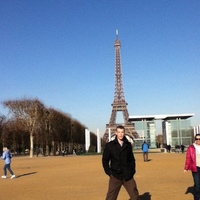
Uploads
Papers by cody ames
personal and societal perceptions potentially rendering a crowd in an intoxicated, wanton state. The association existent between society and its predetermined
allocation of space in many venues (e.g. hippodromes, theaters, amphitheaters, etc.) which exhibit sports and spectacles, more generally, is well attested to in the Circus
Maximus’s history. Using this as the conceptual framework, this article attempts to assess the recurrent, measured, and far-ranging evolutions and interdependencies
between the aristocracy and the Circus they constructed. The construction methodology,
I argue, was constantly being adapted to suit specific political agendas beginning with its legendary foundation under the Etruscan kings in the sixth-century BCE
and ending with its usage during late Empire in the fifth-century CE. The fictional rape of the Sabine women, for example, relates Roman notions of losing self and
spatial awareness as a hazardous mistake which can be purposely leveraged by manipulating a predestined, popular situation “monstra.” The organization of this
article which traces the Circus’s transitions will begin with the Regal Period, move to the Republican Period, then to the Empire. The variations and modifications the Circus Maximus has undergone since the sixth-century BCE—architecturally and usage wise—serves as evidence to both the flexibility of public spaces and usages by the aristocracy from pre-Roman times through the Roman Empire.
Edited Journals by cody ames
Drafts by cody ames
personal and societal perceptions potentially rendering a crowd in an intoxicated, wanton state. The association existent between society and its predetermined
allocation of space in many venues (e.g. hippodromes, theaters, amphitheaters, etc.) which exhibit sports and spectacles, more generally, is well attested to in the Circus
Maximus’s history. Using this as the conceptual framework, this article attempts to assess the recurrent, measured, and far-ranging evolutions and interdependencies
between the aristocracy and the Circus they constructed. The construction methodology,
I argue, was constantly being adapted to suit specific political agendas beginning with its legendary foundation under the Etruscan kings in the sixth-century BCE
and ending with its usage during late Empire in the fifth-century CE. The fictional rape of the Sabine women, for example, relates Roman notions of losing self and
spatial awareness as a hazardous mistake which can be purposely leveraged by manipulating a predestined, popular situation “monstra.” The organization of this
article which traces the Circus’s transitions will begin with the Regal Period, move to the Republican Period, then to the Empire. The variations and modifications the Circus Maximus has undergone since the sixth-century BCE—architecturally and usage wise—serves as evidence to both the flexibility of public spaces and usages by the aristocracy from pre-Roman times through the Roman Empire.